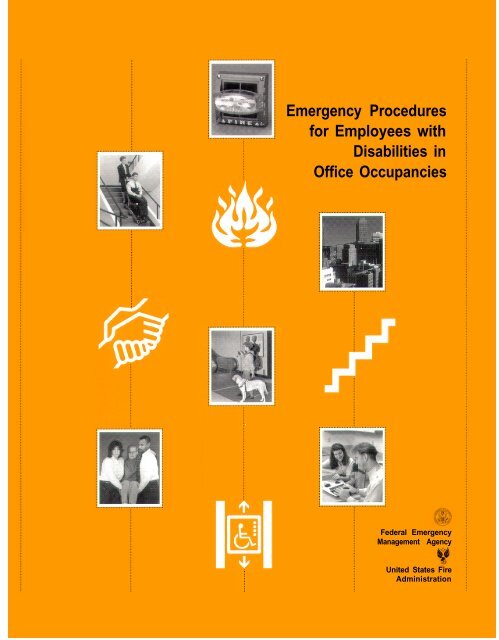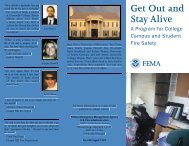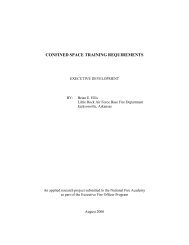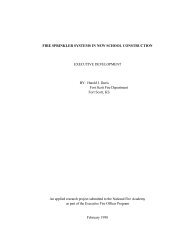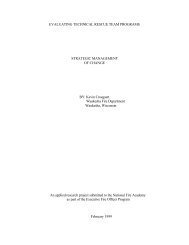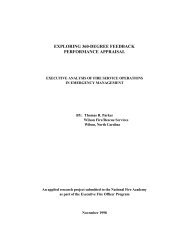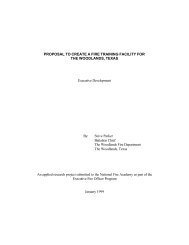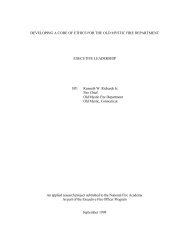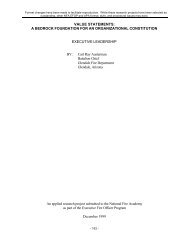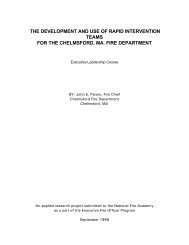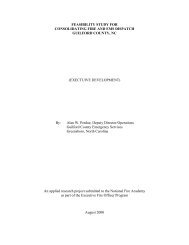Emergency Procedures for Employees with Disabilities - US Fire ...
Emergency Procedures for Employees with Disabilities - US Fire ...
Emergency Procedures for Employees with Disabilities - US Fire ...
Create successful ePaper yourself
Turn your PDF publications into a flip-book with our unique Google optimized e-Paper software.
<strong>Emergency</strong> <strong>Procedures</strong><br />
<strong>for</strong> <strong>Employees</strong> <strong>with</strong><br />
<strong>Disabilities</strong> in<br />
Office Occupancies<br />
Federal <strong>Emergency</strong><br />
Management Agency<br />
United States <strong>Fire</strong><br />
Administration
This document was scanned from hard copy to portable document <strong>for</strong>mat (PDF)<br />
and edited to 99.5% accuracy. Some <strong>for</strong>matting errors not detected during the<br />
optical character recognition process may appear.
C O N T E N T S<br />
Acknowledgements .......................... ii<br />
<br />
I. Introduction ............................. 1<br />
<br />
Detection ............................. .2<br />
Notification. ............................ 2<br />
Movement ............................. 3<br />
How to Proceed. ......................... 3<br />
II. Planning ............................. . . 4<br />
<br />
Identifying Special Needs. .................. 4<br />
Discussion With the Individual .............. 5<br />
Put It in Writing ......................... 5<br />
Periodic Review ......................... 5<br />
III. Special Equipment/Devices ............... 7<br />
<br />
Notification Appliances .................... 7<br />
Movement Aids/Equipment ................ 9<br />
Elevators. ............................. 12<br />
Miscellaneous Devices. ................... 12<br />
Sprinklered Buildings .................... 12<br />
Areas of Refuge/Rescue Assistance .......... 13<br />
IV. Providing Assistance .................... 14<br />
<br />
Identifying Those With Special Needs ........ 14<br />
Buddy Systems and <strong>Fire</strong> Wardens ........... 14<br />
Spontaneous Assistance Techniques ......... 16<br />
<strong>Fire</strong> Department Coordination. ............. 20<br />
After Working Hours. .................... 20<br />
V. Glossary ............................... 21<br />
<br />
Critical Language. ....................... 24<br />
VI. Resources ............................. 25<br />
<br />
VII. References ........................... 26
A C K N O W L E D G E M E N T S<br />
With funding from the United States <strong>Fire</strong><br />
Administration, this guide was develop by the<br />
National Institute of Standards and Technology<br />
<strong>with</strong> assistance from the National Task Force on<br />
Life Safety and People <strong>with</strong> <strong>Disabilities</strong>.<br />
For additional copies of this publication write to:<br />
United States <strong>Fire</strong> Administration<br />
16825 South Seton Avenue<br />
Emmitsburg, Maryland 21727<br />
ii<br />
Review Panel<br />
The following individuals comprised our Review<br />
Panel. Their willingness to serve through the<br />
planning session, resource, draft review.... sometimes<br />
at a moment’s notice and always ready<br />
<strong>with</strong> advice and in<strong>for</strong>mation <strong>for</strong> inclusion in this<br />
guide.<br />
Brian Black<br />
Eastern Paralyzed Veterans Association<br />
Marianne Cashatt<br />
Consultant. Disability Awareness/Public Relations<br />
Alan Clive<br />
Federal <strong>Emergency</strong> Management Agency<br />
Eunice Fiorito<br />
Rehabilitation Services Administration<br />
Victor Galloway<br />
Rehabilitation Services Administration<br />
Anne Hirsh<br />
Job Accommodation Network, affiliate of PCEPWD<br />
Marsha Mazz<br />
U.S. Architectural 6 Transportation Barriers Compliance<br />
Board<br />
Bill Scott<br />
Abilities Unlimited<br />
Certain commercial equipment or products are identified in<br />
this guide as representative examples of products which are<br />
available <strong>for</strong> the purposes discussed. Such identification does<br />
not imply endorsement by the U.S. Government nor does it<br />
imply that the equipment identified is necessarily the best<br />
available <strong>for</strong> the purpose.
I N T R O D U C T I O N<br />
People <strong>with</strong><br />
disabilities are increasingly<br />
moving<br />
into the mainstream<br />
of society, contributing<br />
to the diversity<br />
which has been this<br />
country’s strength.<br />
It is only right that<br />
they be provided<br />
<strong>with</strong> the same level<br />
of safety as the rest<br />
of society, as referenced<br />
in the Americans<br />
<strong>with</strong> <strong>Disabilities</strong><br />
Act (ADA).<br />
Equipment and procedures<br />
exist that<br />
can provide such<br />
safety <strong>for</strong> any person<br />
<strong>with</strong> a disability<br />
that is not so severe<br />
that it would preclude<br />
the ability to<br />
work. The key<br />
points regarding<br />
finding the best<br />
solution <strong>for</strong> your<br />
building are, first, to<br />
remember that<br />
every person <strong>with</strong> a<br />
disability has unique<br />
abilities and limitations,<br />
and accommodations<br />
should<br />
be tailored to their<br />
needs. Second, it is<br />
crucial that the person<br />
be included in<br />
the decision on<br />
which equipment<br />
and procedures will<br />
work <strong>for</strong> them to<br />
provide them <strong>with</strong><br />
the confidence that<br />
they will be protected.<br />
It is every<br />
employer’s responsibility<br />
to provide a<br />
safe place <strong>for</strong> all<br />
employees to work.<br />
<strong>Employees</strong> <strong>with</strong> disabilities<br />
are entitled<br />
to THE SAME level<br />
of safety as everyone<br />
else (no<br />
more/no less). The<br />
“reasonable accommodation”<br />
as mandated<br />
in ADA is<br />
intended only to<br />
provide this same<br />
level of safety and<br />
utility as is provided<br />
1<br />
to everyone.<br />
Further, we cannot<br />
predict when any<br />
one of us may need<br />
assistance, such as<br />
in the case of a broken<br />
leg or the development<br />
of heart disease.<br />
The underlying<br />
principle in providing<br />
safety from fire<br />
and smoke in buildings<br />
is that of safe<br />
egress: the efficient<br />
relocation of building<br />
occupants to an<br />
area of safety usually<br />
outside the building.<br />
This depends<br />
on several steps.<br />
First, we must provide<br />
<strong>for</strong> detection<br />
of a fire, be<strong>for</strong>e it<br />
can interfere <strong>with</strong><br />
the movement of<br />
people. Next comes<br />
notification of the<br />
people that a potential<br />
danger exists<br />
and that evacuation<br />
to a predetermined<br />
point of safety<br />
should begin. Third<br />
is the movement of<br />
people through the<br />
building spaces to a<br />
protected exitway<br />
by which they can<br />
leave the building.<br />
The techniques<br />
<strong>for</strong> detection, notification<br />
and movement are<br />
generally appropriate<br />
<strong>for</strong> anyone in any<br />
setting, but there are<br />
some exceptions.<br />
For example, special<br />
considerations are<br />
required <strong>with</strong> regard<br />
to movement in the<br />
case of the “limited<br />
mobility” of the<br />
patients in health<br />
care occupancies and<br />
the “limitations<br />
imposed” on the<br />
occupants in correctional<br />
occupancies.<br />
Both of these occupancies<br />
require special<br />
considerations<br />
<strong>with</strong> regard to movement,<br />
or a higher
level of protection<br />
(such as “defend in<br />
place”), which does<br />
not require movement.<br />
For other<br />
occupancies, the<br />
presence of individuals<br />
<strong>with</strong> temporary<br />
or permanent disabilities<br />
requires<br />
some additional<br />
planning.<br />
The purpose of<br />
this guide is to provide<br />
in<strong>for</strong>mation <strong>for</strong><br />
facilities managers<br />
and may be useful<br />
<strong>for</strong> those individuals<br />
who might need<br />
special assistance as<br />
to the notification of<br />
an emergency situation<br />
and/or in the<br />
evacuation of a<br />
building. The in<strong>for</strong>mation<br />
includes<br />
examples of equipment<br />
available as<br />
well as suggestions<br />
on procedures and<br />
comments on some<br />
of the advantages<br />
and the disadvantages.<br />
By starting<br />
<strong>with</strong> the same in<strong>for</strong>mation,<br />
options can<br />
be discussed and a<br />
decision on the best<br />
approach to providing<br />
<strong>for</strong> the individ<br />
uals needs can be<br />
made. This discus-<br />
sion is a crucial step<br />
because each person’s<br />
capabilities and<br />
limitations are<br />
unique; thus plans<br />
must be designed to<br />
meet the needs of<br />
the individual to be<br />
most effective.<br />
Detection<br />
The detection<br />
of fires is generally<br />
accomplished by<br />
automatic systems<br />
that do not require<br />
human intervention.<br />
Generally, no special<br />
accommodations are<br />
needed <strong>for</strong> people<br />
<strong>with</strong> disabilities.<br />
One exception<br />
is where manual<br />
pull stations are provided<br />
in public<br />
buildings by which<br />
persons can initiate<br />
a fire alarm if they<br />
discover a fire be<strong>for</strong>e<br />
it is detected by the<br />
automatic system.<br />
In recent years,<br />
codes have been<br />
revised to require<br />
that these manual<br />
pull stations be<br />
mounted at a height<br />
to be <strong>with</strong>in the<br />
"reach range" of 48"<br />
to 54" <strong>for</strong> the person<br />
in a wheel chair.<br />
Facility managers<br />
2<br />
Alarms: Strobe and Horn, left, and Strobe <strong>for</strong> the Hearing<br />
Impaired, right, are “ADA” and “UL Standard 1971” compliant.<br />
should also consider<br />
that not all people<br />
possess the strength<br />
and/or dexterity to<br />
operate some of the<br />
manual pull station<br />
devices (e.g., those<br />
<strong>with</strong> arthritis or<br />
quadriplegia).<br />
Notification<br />
Notification<br />
refers to the process<br />
of in<strong>for</strong>ming occupants<br />
that an emergency<br />
exists and<br />
that some action is<br />
needed. In most<br />
cases, this action is<br />
simply to evacuate,<br />
and the quantity of<br />
in<strong>for</strong>mation to be<br />
given is only this<br />
fact. Traditionally,<br />
notification of an<br />
emergency has been<br />
accomplished by<br />
audible devices,<br />
which are effective<br />
<strong>for</strong> all but those<br />
<strong>with</strong> hearing impairments.<br />
Recently,<br />
visible devices (high<br />
intensity flashing<br />
lights) are being<br />
used along <strong>with</strong> the<br />
audible devices to<br />
broaden the range<br />
of notification effectiveness.<br />
In larger buildings,<br />
emergency<br />
evacuation may<br />
involve relocation to<br />
a safe area <strong>with</strong>in<br />
the building or<br />
sequencing evacuation<br />
by floor or area<br />
so as not to overload<br />
the stairways. In<br />
such cases, the<br />
amount of in<strong>for</strong>mation<br />
that must be<br />
provided to occupants<br />
is substantially<br />
greater. This is typically<br />
done audibly,<br />
through emergency
paging systems.<br />
These are effective<br />
<strong>for</strong> all except those<br />
<strong>with</strong> hearing impairments<br />
where textural<br />
displays, (television<br />
monitors or<br />
scrolling text signs)<br />
are located throughout<br />
the building, or<br />
portable devices<br />
(tactile/vibratory<br />
pagers) have been<br />
utilized effectively.<br />
Movement<br />
By far, the<br />
greatest range of<br />
special needs exists<br />
in the area of movement<br />
of persons to<br />
safe areas. People<br />
using wheelchairs or<br />
<strong>with</strong> other obvious<br />
mobility disabilities<br />
come immediately<br />
to mind; but, there<br />
are many who may<br />
not appear to have a<br />
disability who will<br />
also require some<br />
special assistance.<br />
Permanent<br />
conditions such as<br />
arthritis or temporary<br />
conditions such<br />
as a sprained ankle<br />
or a broken leg can<br />
limit one’s ability to<br />
evacuate quickly<br />
and safely. Heart<br />
disease, emphysema,<br />
asthma, or pregnancy<br />
can reduce stamina<br />
to the point of<br />
needing assistance<br />
when moving down<br />
many flights of stairs.<br />
One major<br />
challenge is the<br />
identification of<br />
those individuals<br />
who may need the<br />
special assistance.<br />
Consider persons<br />
<strong>with</strong> emphysema,<br />
asthma and other<br />
respiratory conditions<br />
who may per<strong>for</strong>m<br />
well in a drill<br />
but then experience<br />
problems in an actual<br />
emergency situation,<br />
as learned in<br />
the World Trade<br />
Center evacuation<br />
as a result of the<br />
February 1993<br />
bombing. The people<br />
<strong>with</strong> respiratory<br />
conditions who<br />
were interviewed,<br />
described the terror<br />
they experienced<br />
when faced <strong>with</strong> the<br />
grim reality of<br />
extreme exertion<br />
required to escape<br />
down the many<br />
3<br />
flights of stairs in<br />
unfamiliar and<br />
smoke-filled stair<br />
towers. They also<br />
explained that prior<br />
to that emergency<br />
evacuation they had<br />
never considered<br />
themselves as having<br />
a disability that<br />
would qualify them<br />
as potential candidates<br />
<strong>for</strong> inclusion<br />
in the emergency<br />
evacuation plans <strong>for</strong><br />
those requiring special<br />
assistance.<br />
How to Proceed<br />
There will<br />
always be someone<br />
who will need some<br />
special assistance in<br />
the event of a fire or<br />
other emergency<br />
requiring evacuation.<br />
Thus, identifying<br />
these individuals<br />
is essential, never<br />
losing sight of the<br />
fact that some of<br />
these people may<br />
not recognize their<br />
own need <strong>for</strong> assistance.<br />
In addition,<br />
allowances <strong>for</strong> visitors<br />
present in the<br />
building must also<br />
be made.<br />
Once identified,<br />
individuals should<br />
be consulted about<br />
their specific limita-<br />
tions and how best<br />
to provide assistance.<br />
Finally, the<br />
methods <strong>for</strong> accommodation<br />
and assistive<br />
devices should<br />
be selected and discussed.<br />
This is necessary<br />
to assure a safe<br />
“emergency” evacua<br />
tion from the building<br />
<strong>for</strong> the individual<br />
<strong>with</strong> a disability.<br />
The remainder<br />
of this guide is intended<br />
to present<br />
the range of possible<br />
approaches to the<br />
accommodation of<br />
special needs along<br />
<strong>with</strong> the advantages<br />
and disadvantages.<br />
From this, it is<br />
expected that the<br />
facility management<br />
and the affected<br />
individuals can make<br />
a more in<strong>for</strong>med<br />
decision on what<br />
approach would<br />
work best <strong>for</strong> the<br />
specific conditions<br />
present. All concerned<br />
should operate<br />
<strong>with</strong> a common<br />
understanding of the<br />
options so that an<br />
optimum solution<br />
can be reached.
II. P L A N N I N G<br />
Identifying<br />
Special Needs<br />
While the<br />
Americans <strong>with</strong><br />
<strong>Disabilities</strong> Act of<br />
1990 (ADA) does<br />
not require <strong>for</strong>mal<br />
emergency plans,<br />
Titles I and III do<br />
require that policies<br />
and procedures of<br />
public accommoda -<br />
tions be modified to<br />
include people <strong>with</strong><br />
disabilities. The<br />
facility emergency<br />
plan which may<br />
already have provisions<br />
<strong>for</strong> individuals<br />
<strong>with</strong> limited mobility<br />
must now include<br />
all the other classifications<br />
of disabilities<br />
as covered in the<br />
ADA. These include:<br />
Individuals <strong>with</strong><br />
varying degrees of<br />
mobility impairments,<br />
ranging from<br />
slow walkers to<br />
wheelchair users.<br />
Individuals who<br />
are visually<br />
impaired and may<br />
require special assistance<br />
in learning the<br />
emergency evacuation<br />
routes or assistance<br />
in proceeding<br />
down exit stairs.<br />
4<br />
Intele-Modem converts a personal computer into a TDD. It<br />
also automatically converts PC (ASCII) to TDD (Baudot);<br />
directly connects to phone lines; automatically detects both<br />
Baudot and ASCII calls; and is FCC approved.<br />
Clarity Phone <strong>with</strong> built-in equalizer automatically tunes,<br />
tones and balances sounds to improve clarity, making words<br />
clearer, not just louder. The phone is designed to help those<br />
<strong>with</strong> high frequency hearing loss, a problem affecting 95% of<br />
the people who are hard-of-hearing. The Clarity adjustment<br />
controls set the high frequency that is right <strong>for</strong> each individual.
Individuals <strong>with</strong><br />
hearing impairments<br />
and who may require<br />
modification to the<br />
standard audible<br />
alarms.<br />
Individuals <strong>with</strong><br />
temporary impairments<br />
due to recovery<br />
from serious<br />
medical conditions<br />
such as stroke or<br />
traumatic injuries<br />
such as a broken leg<br />
or a sprained ankle<br />
or surgeries such as<br />
a knee or hip<br />
replacement.<br />
Individuals <strong>with</strong><br />
medical conditions<br />
such as respiratory<br />
disorders or pregnancy<br />
who may tire<br />
easily, need special<br />
assistance or more<br />
time to evacuate.<br />
Individuals <strong>with</strong><br />
mental impairments<br />
who may become<br />
confused when<br />
challenged <strong>with</strong> the<br />
unusual activity<br />
during an emergency,<br />
lose their<br />
sense of direction, or<br />
may require having<br />
emergency directions<br />
that are broken<br />
down into simplified<br />
steps or basic<br />
concepts.<br />
Other populations<br />
that need to be considered<br />
as being vulnerable,<br />
such as visitors<br />
or customers<br />
Shake-Up System. 9-V battery smoke detector, signal unit,<br />
and vibrator alert device. Detector and receiver attach to<br />
wall and/or ceiling <strong>with</strong> a vibrator device placed on the desk.<br />
A smoke detector sends a transmitted signal to the receiver<br />
and activates the vibrator.<br />
5<br />
<strong>with</strong> small children<br />
who require extra<br />
time to evacuate<br />
down stairs, or<br />
employees who<br />
work outside the<br />
normal working<br />
hours. All of these<br />
individuals need to<br />
have special provisions<br />
or contingencies<br />
included in the<br />
emergency plan <strong>for</strong><br />
their protection.<br />
Discussion<br />
<strong>with</strong> the<br />
Individual<br />
Keep in mind<br />
that someone <strong>with</strong> a<br />
permanent or major<br />
impairment generally<br />
knows the best<br />
way to be assisted.<br />
A minute or so spent<br />
talking <strong>with</strong> the individual<br />
will give<br />
you crucial in<strong>for</strong>mation.<br />
People providing<br />
assistance should<br />
be trained on how<br />
to help <strong>with</strong>out<br />
causing injury to<br />
themselves or others.<br />
This is especially<br />
relevant if someone<br />
needs to be lifted<br />
or carried.<br />
Put in Writing<br />
Identify and<br />
plan <strong>for</strong> times (of<br />
the day and the<br />
week) plus locations<br />
in the workplace<br />
where the basic life<br />
safety or emergency<br />
contingency plans<br />
have not been put<br />
in place or due, to<br />
some other factor,<br />
might not work.<br />
Periodic Review<br />
Innovative educational<br />
techniques<br />
such as role playing<br />
or the use of audiovisual<br />
aids might<br />
prove more effective<br />
than more traditional<br />
methods of in<strong>for</strong>mationdissemination<br />
used in the<br />
past. Practice using<br />
the elements of sections<br />
II and III that<br />
you have selected as<br />
being appropriate<br />
<strong>for</strong> your workplace.<br />
Practice will instill<br />
confidence in one’s<br />
ability to cope in an
emergency. It will<br />
also do more than<br />
anything else to<br />
assure that appropriate<br />
lifesaving actions<br />
will be taken during<br />
a real emergency.<br />
Practice consists<br />
of one of three types<br />
of activity, - walk<br />
through procedures,<br />
announced drills or<br />
surprise drills.<br />
Walk through<br />
<strong>Procedures</strong><br />
Practice separate<br />
parts of a plan<br />
one at a time. In<br />
this way you can<br />
concentratc your<br />
ef<strong>for</strong>ts on the particular-<br />
parts and par.-<br />
ticular individuals<br />
requiring more<br />
extensive practice.<br />
Members of an<br />
emergency response<br />
organization (e.g.,<br />
6<br />
fire wardens) would<br />
be prime candidates<br />
<strong>for</strong> this practice<br />
This is also a way of<br />
introducing newly<br />
hired employees in<br />
the workplace to<br />
important parts of<br />
the plan.<br />
Announced Drills<br />
As <strong>with</strong> the<br />
walk through procedures,<br />
this is intended<br />
more to train than<br />
to evaluate. Such<br />
drills will help identily<br />
crucial coordination<br />
activities and<br />
communication links.<br />
Surprisc Drills<br />
Use these drills<br />
infrequently. Depending<br />
on the situation,<br />
this might be<br />
done once or twice<br />
each year. Surprise<br />
drills should involve<br />
some realistic elements<br />
(e.g., blocked<br />
exits.)<br />
Panic has rarely<br />
been reported, either<br />
in drills or in actual<br />
emergencies.<br />
Ultratec Superprint ES This<br />
portable, 20-character display<br />
Telecommunications<br />
Device <strong>for</strong> the Deaf (TDD)<br />
provides printed records of<br />
conversations and optional<br />
auto-answer.
III. SPECIAL E Q U I P M E N T / D E V I C E S<br />
Notification<br />
Appliances<br />
The disability<br />
that most affects the<br />
process of notification<br />
of an emergency<br />
condition is<br />
hearing impairment.<br />
Hearing impairments<br />
can range from mild<br />
hearing loss to an<br />
extreme of profound<br />
deafness, the level at<br />
which individuals<br />
receive no benefit<br />
from aural input.<br />
Many persons<br />
who are hearing impaired<br />
can use their<br />
residual hearing<br />
effectively <strong>with</strong> assistance<br />
from hearing<br />
aids or other sound<br />
amplification devices,<br />
often augmented by<br />
lip reading.<br />
All-in-One Carrying Case includes: TDD; telephone signaler;<br />
telephone amplifier; door knock signaler; telecaption decoder;<br />
notification vibrator; and visual/audio smoke detector.<br />
However, hearing<br />
aids also amplify<br />
background sounds,<br />
and the sound of<br />
the emergency<br />
alarms may interfere<br />
<strong>with</strong> or even drown<br />
out voice announce-<br />
7<br />
ments of an emergency,<br />
voice communication<br />
system.<br />
Systems used<br />
<strong>for</strong> emergency notification<br />
must comply<br />
<strong>with</strong> UL1971,<br />
the Underwriters<br />
This device was used in<br />
the study conducted in<br />
1988 by Underwriters<br />
Laboratories to evaluate<br />
alternative signaling systems<br />
that would alert persons<br />
<strong>with</strong> hearing impairments<br />
to fires and other<br />
emergency conditions.<br />
The study established<br />
guidelines <strong>for</strong> the use and<br />
installation of the devices<br />
covered in “Standard 1971.”<br />
Laboratories Standard<br />
<strong>for</strong> <strong>Emergency</strong><br />
Signaling Devices <strong>for</strong><br />
the Hearing Impaired.<br />
The signaling devices<br />
covered in the<br />
UL 1971 standard are<br />
designed to alert<br />
persons <strong>with</strong> hearing<br />
impairments<br />
through the use’ of<br />
light, vibrations, and<br />
air movement.<br />
Many hotels<br />
post a sign at the<br />
desk to makc deal<br />
or hearing impaired<br />
guests aware that<br />
rooms <strong>with</strong> strobe<br />
lights arc available.<br />
In some government<br />
buildings,<br />
employees who are<br />
deaf or hard of hearing<br />
have been provided<br />
<strong>with</strong> tactile/vibratory<br />
pagers to notify<br />
them when a fire<br />
alarm has been<br />
activated.<br />
Building managers<br />
who wish to<br />
provide wheelchair<br />
assist equipment <strong>for</strong><br />
use by visitors can<br />
receive assistance in<br />
selecting appropriate<br />
devices from one of<br />
the groups in the<br />
Resources section on<br />
page 25.
Tactile Signage-<br />
Raised Text and<br />
Braille<br />
Braille signs<br />
have been installed at<br />
some locations in<br />
buildings to assist<br />
individuals <strong>with</strong> visual<br />
impairments. You<br />
may have noticed<br />
these raised patterns<br />
of dots on elevator<br />
control panels. The<br />
problem <strong>with</strong> the use<br />
of such labels to mark<br />
egress doors is that<br />
the person must be at<br />
the door in order to<br />
feel the label. Thus,<br />
they provide no<br />
directional guidance<br />
on how to find the<br />
door in the first place.<br />
Audible<br />
Directional<br />
Signage<br />
Audible remote<br />
signage is a way of in-<br />
<strong>for</strong>ming individuals<br />
who are visually impaired<br />
of what they<br />
need to know about<br />
their environment.<br />
Audible directional<br />
instructions<br />
arc transmitted by<br />
low power radio<br />
waves or infrared<br />
beams. The signal/<br />
instructions are then<br />
picked up by a small<br />
receiver carried by<br />
the individual (e.g.,<br />
“the exit is 25 steps<br />
south of the front<br />
desk,” or simply<br />
“stairway,” “restroom,”<br />
or “elevator”) act as<br />
signals when one<br />
approaches a stairway,<br />
rest -room or<br />
elevator.<br />
Audible Pedestrian<br />
Systems<br />
Another example<br />
of audible signs<br />
8<br />
Talking Signs TM provide people who are blind <strong>with</strong> the directional<br />
and usage clues that traditional visual signs provide <strong>for</strong><br />
sighted persons. By sending in<strong>for</strong>mation from installed<br />
infrared transmitters these signs speak <strong>for</strong> themselves.<br />
Hand held sensors pick up in<strong>for</strong>mation from the transmitters<br />
and give verbal directions to the blind individual (see illustration<br />
above). These signs are installed in the San Francisco<br />
Municipal Railway and Bay Area Rapid Transit District.
is the common<br />
pedestrian traffic<br />
signal. These signs<br />
“cuckoo” and<br />
“chirp” to alert pedestrians<br />
to changing<br />
traffic signals. But,<br />
these devices have<br />
some inherent limitations<br />
<strong>for</strong> those<br />
<strong>with</strong> learning disabilities.<br />
They are<br />
not currently in use<br />
<strong>for</strong> emergency egress<br />
systems <strong>with</strong>in<br />
buildings, although<br />
there are exit signs<br />
available that flash<br />
and sound internal<br />
horns when activated<br />
by the building<br />
fire alarm system.<br />
Movement<br />
Aids/Equipment<br />
Another area<br />
where disabilities<br />
impact on emergency<br />
egress is <strong>with</strong><br />
mobility limitations.<br />
This is most frequently<br />
associated<br />
<strong>with</strong> wheelchair<br />
users. Here we<br />
should be sensitive<br />
to the fact that<br />
wheelchairs represent<br />
mobility and<br />
are frequently fitted<br />
to accommodate the<br />
specific physical<br />
needs of the user.<br />
Thus, whether evacuated<br />
<strong>with</strong> or <strong>with</strong>out<br />
their wheelchairs,<br />
they will<br />
need their own<br />
chairs when they<br />
reach safety <strong>for</strong> both<br />
physical and psychological<br />
reasons.<br />
Permanently<br />
Installed Systems<br />
There are several<br />
types of controlled<br />
descent<br />
devices that can be<br />
permanently<br />
installed <strong>with</strong>in<br />
stairways to accommodate<br />
wheelchair<br />
users. In some, the<br />
individual transfers<br />
from the wheelchair<br />
to the portable, controlled<br />
descent chair.<br />
Some models permit<br />
a relatively small<br />
person to transport<br />
a larger person<br />
while <strong>with</strong> other<br />
devices, the individuals<br />
ideally should<br />
be about the same<br />
weight. These<br />
chairs are designed<br />
to travel down stairs<br />
on special tracks<br />
<strong>with</strong> friction braking<br />
systems, rollers or<br />
other devices to<br />
control the speed of<br />
descent.<br />
9<br />
Another type of<br />
controlled descent<br />
device is designed so<br />
the wheelchair user<br />
rolls onto the transport<br />
device and the<br />
wheelchair is<br />
secured to the<br />
device. This has the<br />
advantage that the<br />
wheelchair user<br />
does not have to be<br />
separated from the<br />
chair - a situation<br />
that will be more<br />
com<strong>for</strong>table and<br />
reassuring.<br />
The wheelchair<br />
lift is a motor-driven<br />
device designed to be<br />
installed in a stairway.<br />
Vertical wheel-<br />
Wheelchair lifts <strong>for</strong> use<br />
indoors,top, and <strong>for</strong> use<br />
outdoors, bottom.
T M<br />
Garaventa EVACU-TRAC<br />
Developed in Switzerland<br />
Top Convenient, top of<br />
stair storage. Middle.<br />
1. Brake system engages<br />
when lever is released;<br />
2. Adjustable safety belts;<br />
3. Rubber tracks grip<br />
stairs; 4. Eight auxiliary<br />
wheels <strong>for</strong> smoother ride<br />
on flat surfaces, such as<br />
stair landings. Bottom:<br />
Designed so a passenger’s<br />
weight propels it down<br />
stairs. Governor limits the<br />
maximum descent speed.<br />
10<br />
EVAC+CHAIR TM ‘300-H’<br />
Top Folds <strong>for</strong> on-the-job<br />
storage. Can be readily<br />
available <strong>for</strong> emergencies<br />
Middle- Unfolds/opens<br />
quickly and Weighs only<br />
15 pounds but has a 300Ib.<br />
capacity. Cantilevered<br />
design places seat inches<br />
above stairs. Other features:<br />
sliding head rest;<br />
quick-release safety belt<br />
buckle; and instructions<br />
permanently stamped on<br />
back. Bottom: Changes the<br />
obstacle of firestairs into<br />
usable escape route <strong>for</strong><br />
all, e.g., pregnant women,<br />
the frail or employees <strong>with</strong><br />
limited stamina, or someone<br />
<strong>with</strong> a temporary<br />
disability.
T M<br />
Scalamobil<br />
Stairclimbing and power<br />
unit, invented in Germany<br />
Three-step process <strong>for</strong><br />
use. Top: First, attach handles<br />
to the Scalamobil.<br />
Second, attach Scalamobil<br />
to wheelchair. Third,<br />
begin operation. Middle:<br />
12V/12AH power base.<br />
Bottom: Operator’s safety<br />
features include: automatic<br />
mechanical security<br />
brakes on every wheel;<br />
variable speed control<br />
from 6-12 steps per<br />
minute, and ability to park<br />
the wheelchair safely on<br />
any step during ascent or<br />
descent. Designed to<br />
negotiate most all stairs,<br />
from the extremely narrow<br />
stair to curving circular<br />
stairs.<br />
Chair lifts arc differentiated<br />
from elevators<br />
in that they arc’<br />
limited in the height<br />
of their vertical lift,<br />
arc not enclosed, and<br />
do not go through a<br />
floor level. These<br />
11<br />
lifts were originally the wheelchair user<br />
intended <strong>for</strong> private as to the selection of<br />
residences, but are an emergency evacnow<br />
being used in uation chair. The<br />
nursing homes, advantages or disadchurches<br />
and public vantages of these<br />
buildings. devices are depen-<br />
Always consult<br />
dent on the capabili-<br />
Evacuation Assistance Device<br />
A three-person,assisted-wheelchair-carry<br />
device,<br />
called “Evac-u-<br />
Straps,” was developed<br />
by a wheelchair<br />
user. It consists<br />
of wide padded<br />
leather wrist bands<br />
<strong>with</strong> velcro closures<br />
equipped <strong>with</strong> large<br />
metal grasping<br />
hooks. The hooks<br />
are designed to be<br />
attached to both<br />
sides of the front of<br />
the wheelchair.<br />
Persons on either<br />
side of the wheelchair<br />
grasp the<br />
straps and are<br />
assisted by a third<br />
person behind,<br />
keeping the wheelchair<br />
slightly tipped<br />
backwards. The<br />
wheelchair user<br />
assists by handbraking<br />
the wheels. Photos by Jake Pauls, Building<br />
Use and Safety Institute
ties, acceptance, and<br />
understanding of the<br />
end user(s). The<br />
effectiveness or failure<br />
of evacuation<br />
chairs as a rule can<br />
be attributed to the<br />
fact that the wheelchair<br />
user was not<br />
consulted as to the<br />
equipment selection.<br />
Chairs that do not<br />
accommodate the<br />
physical needs of the<br />
user create problems<br />
which may lead to a<br />
refusal to use them<br />
in an emergency.<br />
Elevators<br />
Most people are<br />
familiar <strong>with</strong> the fact<br />
that elevators are not<br />
to be used <strong>for</strong> emergency<br />
egress and are<br />
so marked in most<br />
buildings. Elevator<br />
codes require that<br />
when smoke detectors<br />
in elevator lobbies<br />
activate, the elevator<br />
is recalled to<br />
the ground floor (as<br />
long as the ground<br />
floor smoke detector<br />
is not the one that<br />
alarmed) and is<br />
taken out of service.<br />
The fire department<br />
can operate the elevator<br />
<strong>with</strong> a special<br />
key and may use it<br />
to move their people<br />
and equipment, or<br />
<strong>for</strong> evacuation of<br />
occupants. This<br />
means that <strong>with</strong>out<br />
the fire department,<br />
persons <strong>with</strong> disabilities<br />
are relegated<br />
to the stairs or must<br />
await rescue.<br />
In recent years<br />
(especially since the<br />
1993 World Trade<br />
Center bombing ),<br />
there has been a<br />
growing interest in<br />
providing elevators<br />
that can be used <strong>for</strong><br />
emergency evacua -<br />
tion. In a study conducted<br />
<strong>for</strong> the General<br />
Services Administration<br />
(GSA), the<br />
National Institute of<br />
Standards and<br />
Technology (NIST)<br />
found that the use of<br />
both elevators and<br />
stairs can improve<br />
evacuation times by<br />
as much as 50%<br />
over stairs alone.<br />
However, elevators<br />
that are used<br />
<strong>for</strong> emergency evacuation<br />
need to be<br />
specially designed to<br />
assure their reliability<br />
and safety during<br />
the fire. NIST<br />
research has shown<br />
that, <strong>with</strong> enclosed<br />
lobbies at each floor<br />
12<br />
which are pressurized<br />
through the<br />
shaft so that both<br />
remain smoke free,<br />
dual power systems<br />
<strong>for</strong> reliability, and<br />
water resistant components<br />
to prevent<br />
failure due to flooding<br />
of the shaft by<br />
firefighting water, it<br />
is feasible to design<br />
elevators that are sufficiently<br />
safe to allow<br />
their continued use<br />
<strong>for</strong> emergency evacuation.<br />
(Feasibility of<br />
<strong>Fire</strong> Evacuation by Elevators<br />
at FAA Control<br />
Towers, NISTIR 5445,<br />
1994.)<br />
Miscellaneous<br />
Devises<br />
A number of<br />
unique escape<br />
devices have been<br />
developed over the<br />
years. These include<br />
controlled descent<br />
devices using cables<br />
and chutes of various<br />
types. The cable<br />
devices usually use a<br />
strap or chair secured<br />
to the cable<br />
by a device that is<br />
squeezed to allow<br />
descent. The more<br />
you squeeze, the<br />
faster you go. Letting<br />
go stops your<br />
descent. Most peo-<br />
ple are reluctant to<br />
evacuate down the<br />
outside of a building.<br />
The chutes may<br />
be solid or flexible<br />
labric tubes that<br />
generally rely on<br />
friction to control<br />
speed. They have<br />
the advantage that<br />
they don’t let you<br />
see out, so they are<br />
more acceptable<br />
than cable devices.<br />
However, their<br />
acceptance in practice<br />
in this country<br />
has been limited.<br />
There is little<br />
in<strong>for</strong>mation available<br />
as to the per<strong>for</strong>mance<br />
of these devices<br />
in emergency situations.<br />
These unique<br />
specialized escape devices<br />
generally have<br />
serious shortcomings.<br />
( Egress <strong>Procedures</strong><br />
Technologies <strong>for</strong> People<br />
<strong>with</strong> <strong>Disabilities</strong>. Final<br />
Report of a State of<br />
the Art Review <strong>with</strong><br />
Recommendations<br />
<strong>for</strong> Action, ATBCB<br />
1988.)<br />
Sprinklered<br />
Buildings<br />
In a study of<br />
areas of refuge conducted<br />
by NIST <strong>for</strong><br />
the GSA, it was con-
cluded that the circumstances, prooperation<br />
of a prop- vide the protection<br />
erly designcd and to permit evacuation<br />
maintained sprinkler that is limited to the<br />
system eliminates area under immedithe<br />
life threat to ate threat from the<br />
building occupants fire. In sprinklered<br />
regardless of their buildings it would<br />
individual abilities probably be approand<br />
can provide priate to put more<br />
superior protection emphasis on under<strong>for</strong><br />
people <strong>with</strong> dis- standing of the proabilities.<br />
Sprinkler tection af<strong>for</strong>ded or<br />
systems will, in most provided <strong>with</strong> the<br />
sprinklers and about<br />
limited evacuation<br />
through horizontal<br />
exits versus total<br />
evacuation from the<br />
building.<br />
Of course, while<br />
about 95% reliable,<br />
there is a small possibility<br />
that the sprinkler<br />
system will fail<br />
to extinguish the fire.<br />
For these possibilities,<br />
there need to be<br />
Area of Refuge/Rescue Assistance<br />
Inside of Exit Stairways<br />
A Horizonal Exit Can Meet the<br />
Requirement <strong>for</strong> Areas of<br />
Rescue Assistance<br />
13<br />
contingency plans <strong>for</strong><br />
providing evacuation<br />
assistance <strong>for</strong> all<br />
occupants, including<br />
those needing special<br />
assistance.<br />
Area of Refuge/<br />
Rescue Assistance<br />
Even in buildings<br />
equipped <strong>with</strong><br />
sprinkler systems it<br />
is recommended<br />
that areas of refuge<br />
be provided. There<br />
is the small possibility<br />
that the sprinkler<br />
system will fail to<br />
extinguish the fire<br />
and there is the<br />
problem of smoke<br />
propagation. It is<br />
quite possible <strong>for</strong> a<br />
person <strong>with</strong> a disability<br />
to be stranded<br />
and overcome<br />
<strong>with</strong> smoke be<strong>for</strong>e<br />
the arrival of the<br />
rescue personnel,<br />
given the difficulty<br />
in locating someone<br />
in a smoke-filled<br />
building. For these<br />
possibilities, there<br />
need to be contingency<br />
plans <strong>for</strong> providing<br />
evacuation<br />
assistance <strong>for</strong> all<br />
occupants, as well as<br />
those needing special<br />
assistance.
IV. P R O V I D I N G A S S I S T A N C E<br />
Identifying<br />
Those <strong>with</strong><br />
Special Needs<br />
Be<strong>for</strong>e special<br />
accommodations<br />
can be made, persons<br />
needing them<br />
must be identified.<br />
One strategy is to<br />
maintain a listing of<br />
individuals needing<br />
assistance and keeping<br />
it current as part<br />
of the facility’s<br />
emergency plan. At<br />
the beginning of<br />
employment during<br />
the orientation<br />
process is the time<br />
to begin to stress the<br />
importance of identifying<br />
if an individual<br />
will need special<br />
assistance. Of<br />
course, since conditions<br />
change and<br />
persons can become<br />
temporarily disabled,<br />
this system<br />
needs to be flexible.<br />
Such lists must<br />
be accessible by the<br />
emergency personnel<br />
to assist in the<br />
emergency evacuation.<br />
But, it should<br />
be understood that<br />
there are many individuals<br />
who are protective<br />
of their right<br />
to independence and<br />
privacy and who<br />
may be reluctant to<br />
have their names<br />
put on such a list.<br />
Some disability categories<br />
are easily recognizable<br />
and in<br />
these cases the indvidual<br />
can be approached<br />
as to what<br />
can be done to assist<br />
them in emergency<br />
evacuation.<br />
It is important<br />
to treat the individual<br />
as one who happens<br />
to have a particular<br />
disability, and<br />
not make the mistake<br />
of “lumping”<br />
together all persons<br />
<strong>with</strong> disabilities in<br />
the development of<br />
emergency procedurcs.<br />
There are<br />
some emergency<br />
plans (and codes on<br />
which they are<br />
based) where all<br />
persons <strong>with</strong> disabilities<br />
were “directed”<br />
to go to the area of<br />
rescue assistance to<br />
await members of<br />
the emergency team<br />
to escort them to<br />
safety. As a general<br />
rule there is no reason<br />
that individuals<br />
who are blind or<br />
deaf cannot use the<br />
stairs to make an<br />
independent escape<br />
14<br />
as long as they can<br />
cffectively be notified<br />
of the need to<br />
evacuate and can<br />
find the stairway).<br />
One of thc<br />
lessons learned from<br />
interviews of people<br />
<strong>with</strong> disabilities following<br />
the February<br />
1993 World Trade<br />
Center bombing was<br />
that, prior to the<br />
incident, some of<br />
the people <strong>with</strong> disabilities<br />
said that, in<br />
the interest of privacy<br />
or because they<br />
felt that they did not<br />
need special assistance,<br />
they) had<br />
opted not to identity)<br />
themselves to be<br />
among those listed<br />
as disabled in the<br />
emergency management<br />
plan. They<br />
realized after the<br />
incident that they<br />
did need assistance<br />
and that they had<br />
not realized how<br />
vulnerable they<br />
were outside of normal<br />
working hours<br />
when there were<br />
few co-workers<br />
around to provide<br />
such assistance.<br />
"Buddy"<br />
Systems and<br />
<strong>Fire</strong> Wardens<br />
Buddy systems<br />
are widely accepted<br />
and used, but have<br />
some inherent faults<br />
or flaws. When set<br />
ting up such a system<br />
in the workplace,<br />
consider the<br />
following potential<br />
problem areas and<br />
potential solutions.<br />
To be effective, the<br />
person and the<br />
buddy must be able<br />
to make contact<br />
<strong>with</strong> each other<br />
quickly when the<br />
need arises. Situations<br />
that can prevent<br />
this include:<br />
The “buddy” is in<br />
the building, but is<br />
absent from the customary<br />
work area<br />
The “buddy” cannot<br />
locate the person<br />
<strong>with</strong> a disability<br />
because the person<br />
is absent from the<br />
customary work<br />
area
The employee<br />
<strong>with</strong> a disability is<br />
working late, etc.,<br />
when the “buddy” is<br />
unavailable<br />
The “buddy” has<br />
left the company)<br />
and a new one has<br />
yet to be identified<br />
The “buddy” has<br />
not been trained in<br />
what to do or how<br />
to assist<br />
The “buddy” is<br />
inappropriate (e.g.,<br />
not strong enough)<br />
The “buddy” isn’t<br />
acceptable to the<br />
employee <strong>with</strong> a<br />
disability<br />
The “buddy” <strong>for</strong>gets<br />
or is frightened<br />
and abandons the<br />
employee <strong>with</strong> a<br />
disability<br />
Now, consider<br />
the lollowing potential<br />
solutions:<br />
Assign at least<br />
“two buddies” who<br />
are work associates.<br />
Alert the floor warden<br />
about the work<br />
location of the person<br />
<strong>with</strong> a disability.<br />
If he/she cannot<br />
locate the assigned<br />
person, the “buddy”<br />
should alert the<br />
floor warden. <strong>Employees</strong><br />
could be<br />
given pagers.<br />
<strong>Employees</strong> <strong>with</strong><br />
disabilities should<br />
identify themselves<br />
to the officials in the<br />
emergency control<br />
center when in the<br />
building after hours.<br />
15<br />
The officials coordinate<br />
immediate<br />
emergency response,<br />
call the employee<br />
and alert responding<br />
fire service.<br />
<strong>Employees</strong> <strong>with</strong><br />
disabilities can be<br />
given the responsibility<br />
<strong>for</strong> selecting<br />
their own “buddies”;<br />
bimonthly emergency<br />
plan reviews<br />
should include<br />
checking the status<br />
of’ “buddies.”<br />
The “buddy” is<br />
trained by the<br />
employee <strong>with</strong> a<br />
disability as soon as<br />
they are recruited.<br />
The employee<br />
<strong>with</strong> a disability is<br />
encouraged to select<br />
only “buddies” who<br />
are capable. Practice<br />
sessions are required<br />
to ensure that “buddies”<br />
can handle<br />
their assigned tasks.<br />
<strong>Employees</strong> <strong>with</strong><br />
disabilities are<br />
encouraged to select<br />
only friends/colleagues<br />
as “buddies.”<br />
New York City leads the nation in a<br />
number of techniques <strong>for</strong> addressing fire<br />
safety in tall buildings, including the designation<br />
of fire wardens. Under Local Law 5,<br />
a fire warden is assigned <strong>for</strong> each floor of a<br />
building, and is responsible <strong>for</strong> the safe<br />
evacuation of persons on that floor. The<br />
fire warden knows who is and is not at<br />
work that day, what visitors are present,<br />
and who might need assistance in case of<br />
emergency. New York fire wardens take<br />
required training at regular intervals. The<br />
law also requires a building fire safety<br />
manager whose full-time job is to keep fire<br />
emergency plans up to date and who coordinates<br />
the activities of the fire wardens<br />
<strong>with</strong> the fire service during an emergency.
Spontaneous<br />
Assistance<br />
Techniques<br />
Vision<br />
Impairments<br />
When assisting<br />
persons <strong>with</strong> vision<br />
impairments there<br />
are some basic. rules<br />
to follow in order to<br />
be effective.<br />
Announce your<br />
presence; speak out<br />
when entering the<br />
work area.<br />
Speak naturally<br />
and directly to the<br />
individual and NOT<br />
through a third<br />
party. Do not shout.<br />
Don’t be afraid to<br />
use words like “see,”<br />
“look,” or “blind.”<br />
Offer assistance<br />
but let the person<br />
explain what help is<br />
needed.<br />
Describe the<br />
action to be taken in<br />
advance.<br />
Let the individual<br />
grasp your arm or<br />
shoulder lightly, <strong>for</strong><br />
guidance. He/she<br />
may choose to walk<br />
slightly behind you<br />
to gauge your body<br />
reactions to obstacles;<br />
be sure to mention,<br />
stairs, doorways,<br />
narrow passages,<br />
ramps, etc.<br />
When guiding to a<br />
seat, place the person's<br />
hand on the<br />
back of the chair.<br />
It leading several<br />
individuals <strong>with</strong><br />
visual impairments<br />
at the same time,<br />
ask them to hold<br />
each other’s hands.<br />
You should ensure<br />
that after exiting the<br />
building that individuals<br />
<strong>with</strong> impaired<br />
vision are not<br />
abandoned” but are<br />
led to a place of<br />
safety, where a colleague(s)<br />
should<br />
remain <strong>with</strong> them<br />
until the emergency)<br />
is over. Another of<br />
the lessons learned<br />
from the World<br />
Trade Center incident<br />
involved the<br />
complaints of blind<br />
tenants who after<br />
being escorted down<br />
Suggestions When Assisting<br />
Owners of Dog Guides<br />
Do not pet or offer the dog food <strong>with</strong>out<br />
the permission of the owner.<br />
When the dog is wearing its harness, he<br />
is on duty; if you want the dog not to<br />
guide its owner, have the person remove<br />
the dog’s harness.<br />
Plan <strong>for</strong> the dog to be evacuated <strong>with</strong><br />
the owner.<br />
In the event you are asked to take the<br />
dog while assisting the individual, it is recommended<br />
that you (the helper) hold the<br />
leash and not the dog’s harness.<br />
16<br />
and out of the<br />
building, were<br />
unceremoniously<br />
left in the unfamiliar<br />
environs out-ofdoors<br />
in the midst<br />
of a winter ice<br />
storm, where they<br />
had to negotiate ice<br />
covered sidewalks<br />
and falling glass<br />
from overhead.<br />
Hearing<br />
Impairments<br />
When assisting<br />
persons <strong>with</strong> hearing<br />
impairments<br />
there are also some<br />
things to keep in<br />
mind. These<br />
include:<br />
Flick the lights<br />
when entering the<br />
work area to get the<br />
person’s attention.<br />
Establish eye contact<br />
<strong>with</strong> the individual,<br />
even if an<br />
interpreter is<br />
present.<br />
Face the light, do<br />
not cover or turn<br />
your face away, and<br />
never chew gum.
Use facial expressions<br />
and hand gestures<br />
as visual cues.<br />
Check to see if<br />
you have been<br />
understood and<br />
repeat if necessary.<br />
Offer pencil and<br />
paper. Write slowly<br />
and let the individual<br />
read as you<br />
write. Written communication<br />
may be<br />
especially important<br />
if you are unable to<br />
understand the individual’s<br />
speech.<br />
Do not allow others<br />
to interrupt or<br />
joke <strong>with</strong> you while<br />
conveying the emergency<br />
in<strong>for</strong>mation.<br />
Be patient, the<br />
individual may have<br />
difficulty comprehending<br />
the urgency<br />
of your message.<br />
Provide the individual<br />
<strong>with</strong> a flashlight<br />
<strong>for</strong> signaling<br />
their location in the<br />
event that they are<br />
separated from the<br />
rescuing team or<br />
buddy and to facilitate<br />
lip-reading in<br />
the dark.<br />
Learning<br />
<strong>Disabilities</strong><br />
Persons <strong>with</strong><br />
learning disabilities<br />
may have difficulty<br />
in recognizing or<br />
being motivated to<br />
act in an emergency<br />
by untrained rescuers.<br />
They may<br />
also have difficulty<br />
in responding to<br />
instructions which<br />
involve more than a<br />
small number of<br />
simple actions.<br />
Some suggestions<br />
<strong>for</strong> assisting such<br />
persons include:<br />
Their visual perception<br />
of written<br />
instructions or signs<br />
may be confused.<br />
Their sense of<br />
direction may be<br />
limited, requiring<br />
someone to accom<br />
pany them.<br />
Directions or<br />
in<strong>for</strong>mation may<br />
need to be broken<br />
down into simple<br />
steps. Be patient.<br />
Simple signals<br />
and/or symbols<br />
17<br />
should be used (e.g.,<br />
the graphics used<br />
throughout this<br />
section).<br />
A person’s ability<br />
to understand<br />
speech is often more<br />
developed than<br />
his/her own vocabulary.<br />
Do not talk<br />
about a person to<br />
others in front of<br />
him/her.<br />
The individual<br />
should be treated as<br />
an adult who happens<br />
to have a cognitive<br />
or learning<br />
disability. Do not<br />
talk down to them<br />
or treat them as<br />
children.<br />
Mobility<br />
lmpairments<br />
Someone using<br />
a crutch or a cane<br />
might be able to<br />
negotiate stairs independently.<br />
One<br />
hand is used to<br />
grasp the handrail<br />
the other hand is<br />
used <strong>for</strong> the crutch<br />
or cane. Here, it is<br />
best NOT to interfere<br />
<strong>with</strong> this person’s<br />
movement.<br />
You might be of<br />
assistance by offering<br />
to carry the<br />
extra crutch. Also,<br />
if the stairs are<br />
crowded, you can<br />
act as a buffer and<br />
“run interference.”<br />
Wheelchair<br />
users are trained in<br />
special techniques to<br />
transfer from one<br />
chair to another.<br />
Depending on their<br />
upper body<br />
strength, they may<br />
he able to do much<br />
of the, work themselves.<br />
If you assist<br />
a wheelchair user,<br />
avoid putting pressure<br />
on the person’s<br />
extremities and<br />
chest. Such pressure<br />
might cause<br />
spasms, pain and<br />
even restrict breathing.<br />
Carrying someone<br />
slung over your<br />
shoulders (something<br />
like the so<br />
called fireman’s<br />
carry) is like sitting<br />
on their chest and<br />
poses danger <strong>for</strong><br />
several individuals<br />
who fall <strong>with</strong>in categories<br />
of neurologic<br />
and orthopedic disabilities.
Carry<br />
Techniques<br />
One-Person Carry<br />
Technique<br />
The CRADLE<br />
LIFT is the preferred<br />
method when the<br />
person to be carried<br />
has little or no arm<br />
strength. It is safer<br />
if the person being<br />
carried weighs less<br />
than the carrier’s<br />
weight.<br />
18<br />
Two-Person<br />
Carry Technique<br />
— The Swing or<br />
Chair Carry<br />
To use this technique<br />
Carriers stand on<br />
opposite sides of the<br />
individual<br />
Take the arm on<br />
your side and wrap<br />
it around your<br />
shoulder.<br />
Grasp your carry<br />
partner’s <strong>for</strong>earm<br />
behind the person<br />
in the small of the<br />
hack.<br />
Reach under the<br />
person’s knees to<br />
grasp the wrist of<br />
your carry partner’s<br />
other hand.<br />
Both carry partners<br />
should then<br />
lean in, close to the<br />
person, and lift on<br />
the count of three.<br />
Continue pressing<br />
into the person<br />
being carried <strong>for</strong><br />
additional support<br />
in the carry.
The advantage<br />
of this carry is that<br />
the partners can<br />
support (<strong>with</strong> practice<br />
and coordination)<br />
a person whose<br />
weight is same or<br />
even greater than<br />
their own weight.<br />
The disadvantage<br />
is increased<br />
awkwardness in vertical<br />
travel (stair<br />
descent) due to the<br />
increased complexity<br />
of the two person<br />
carry. Three persons<br />
abreast may exceed<br />
the effective width<br />
of the stairway.<br />
19<br />
To Assist in Moving a<br />
Wheelchair Downstairs<br />
When descending stairs, stand<br />
behind the chair grasping the pushing<br />
grips. Tilt the chair backwards until a balance<br />
is achieved. Descend frontward.<br />
Stand one step above the chair, keeping<br />
your center of gravity low and let the<br />
back wheels gradually lower to the next<br />
step. Be careful to keep the chair tilted<br />
back. If possible, have another person<br />
assist by holding the frame of the wheelchair<br />
and pushing in from the front. But<br />
do not lift the chair, as this places more<br />
weight on the individual behind.
Other Impairments<br />
Pregnancy is<br />
not usually considered<br />
a disability, but<br />
it can result in reduced<br />
stamina or impaired<br />
mobility, especially<br />
in negotiating stairs.<br />
In these cases, offer to<br />
walk <strong>with</strong> the woman<br />
and be of support<br />
both emotionally and<br />
physically. Remain<br />
<strong>with</strong> her until you<br />
have reached safety<br />
and she has a safe,<br />
warm place to sit,<br />
With respiratory<br />
disorders,<br />
such as asthma or<br />
emphysema, the<br />
onset of symptoms<br />
can be triggered by<br />
stress, exertion, or<br />
exposure to small<br />
amounts of dust or<br />
smoke. Remind the<br />
individual to bring<br />
inhalation medication<br />
be<strong>for</strong>e leaving<br />
the work place.<br />
Persons <strong>with</strong><br />
cardiac conditions,<br />
should be reminded<br />
to take their medications.<br />
Offer them<br />
assistance in walking;<br />
they may have<br />
reduced stamina and<br />
require frequent rest<br />
periods.<br />
<strong>Fire</strong> Department<br />
Coordination<br />
It is vital to<br />
have a clear understanding<br />
through<br />
effective planning<br />
and practice <strong>with</strong><br />
the local fire and<br />
rescue services regarding<br />
evacuation procedures<br />
<strong>for</strong> persons<br />
<strong>with</strong> disabilities.<br />
Opinions can vary<br />
among local fire departments,<br />
<strong>for</strong> example:<br />
Whether individuals<br />
<strong>with</strong> disabilities<br />
should remain in<br />
their workplaces,<br />
assemble in an area<br />
of refuge to await<br />
the arrival of the fire<br />
fighters, or whether<br />
fellow workers should<br />
help <strong>with</strong> their immediate<br />
evacuation.<br />
What evacuation<br />
techniques are to be<br />
used, in particular<br />
the carry techniques<br />
<strong>for</strong> getting nonambulatoryindividuals<br />
down the stairs.<br />
Whether dog<br />
guides should be<br />
permitted to evacuate<br />
down the stairway<br />
<strong>with</strong> their owners.<br />
There are<br />
examples of the fire<br />
department instruct -<br />
ing that the dog be<br />
20<br />
After Working Hours<br />
Most office fire fatalities occur outside<br />
of normal working hours. Here, fires can<br />
grow unnoticed and persons working alone<br />
can be cut off from their normal egress<br />
route. In many buildings, only a few people<br />
working late and the housekeeping staff<br />
are present at night. An employee <strong>with</strong> a<br />
mobility impairment who has relied on the<br />
elevator <strong>for</strong> access may need help to get<br />
down the stairs, but trained “buddies” are<br />
unavailable. To compensate, the individual<br />
should alert building security upon entering<br />
the building. Someone will then be ready<br />
to search <strong>for</strong> and assist the individual to<br />
safety, if needed. Alternatively, the person<br />
could be instructed to telephone the fire<br />
department as to their location when an<br />
emergency occurs.<br />
Managers should ensure that shift<br />
workers and others who work on the<br />
premises outside normal hours, such as<br />
cleaners, are included. If there are employees<br />
whose knowledge of English may be<br />
limited, training should be given in a manner<br />
which they can understand. Non-<br />
English speakers and staff who have poor<br />
reading skills should be considered when<br />
written instructions are being prepared.<br />
separated from its<br />
owner.<br />
Whatever the<br />
plan, what is most<br />
critical is that it be<br />
coordinated and practiced<br />
<strong>with</strong> the local<br />
fire and rescue service.
V. G L O S S A R Y<br />
A<br />
ADA Americans<br />
<strong>with</strong> <strong>Disabilities</strong><br />
Act<br />
ADAAG Americans<br />
<strong>with</strong> <strong>Disabilities</strong><br />
Act Accessibility<br />
Guidelines<br />
Aphasia Absence or<br />
impairment of the<br />
ability to communicate<br />
through<br />
speech, writing or<br />
signs<br />
Area of Refuge<br />
Area of Rescue<br />
Assistance An<br />
area that has<br />
direct access to an<br />
exit, where people<br />
who are are unable<br />
to use stairs<br />
may remain temporarily<br />
in safety<br />
to await further<br />
instructions or<br />
assistance during<br />
emergency evacuation.<br />
Asthma A complex<br />
disease which<br />
causes obstruction<br />
of the respiratory<br />
system<br />
B<br />
Back Pain Can be<br />
caused by congenital<br />
conditions, disease<br />
or injury, but<br />
<strong>for</strong> the millions of<br />
people affected by<br />
this condition the<br />
key element is<br />
always the same,<br />
pain.<br />
Blind/Blindness<br />
Range of vision<br />
impairments from<br />
the inability to distinguish<br />
light and<br />
dark to a loss of<br />
part of the visual<br />
field or the inability<br />
to see detail.<br />
(see definition:<br />
Visually Impaired)<br />
Brailler “Perkins<br />
Brailler,” an allpurpose<br />
Braille<br />
writer.<br />
Buddy System The<br />
system of assigning<br />
the appropriate<br />
individual(s) to<br />
assist in the evacuation<br />
of persons<br />
<strong>with</strong> disabilities.<br />
C<br />
Cane As used by<br />
the blind individual,<br />
the cane is a<br />
natural extension<br />
of the arm and<br />
hand and is used<br />
as an “in<strong>for</strong>mation<br />
gathering” device<br />
(to locate familiar<br />
landmarks) <strong>for</strong> the<br />
purpose of establishing<br />
a clear path<br />
of travel. The<br />
21<br />
conventional twopoint<br />
touch system:<br />
The cane is<br />
moved from side<br />
to side in an arcing<br />
motion. The width<br />
of the arc is usually<br />
two inches to<br />
either side of the<br />
shoulders. As the<br />
cane touches to<br />
the left, the right<br />
foot should be <strong>for</strong>ward.<br />
The cane tip<br />
touches in the<br />
opposite direction<br />
of the leading foot.<br />
Chronic Obstructive<br />
Pulmonary<br />
Disease (COPD)<br />
Includes the diseases<br />
of chronic<br />
bronchitis and<br />
emphysema.<br />
Cerebrovascular<br />
Accident (CVA)<br />
Localized brain<br />
damage due to a<br />
ruptured blood<br />
vessel in the brain;<br />
commonly called a<br />
stroke.<br />
Cerebral Palsy<br />
Non-progressive<br />
disorder of the<br />
brain, results from<br />
damage to the<br />
nervous system at<br />
birth or in the first<br />
hours or days of<br />
life; not a disease.<br />
Closed Circuit TV<br />
Magnifier<br />
(CCTV) Consists<br />
of television camera<br />
which takes<br />
the picture of the<br />
printed page and a<br />
television monitor<br />
which displays<br />
image in enlarged<br />
<strong>for</strong>m.<br />
Critical Language<br />
Terminology that<br />
is unacceptable<br />
and/or insulting to<br />
persons <strong>with</strong> disabilities.<br />
(see list<br />
on p. 24).<br />
D<br />
Deaf/Deafness<br />
Range of auditory<br />
impairments, from<br />
a total lack of sensitivity<br />
to sound to<br />
reduced sensitivity<br />
to certain sound<br />
frequencies.<br />
Dog Guide Dog<br />
that has been specially<br />
trained to<br />
assist people who<br />
are blind, physically<br />
disabled or<br />
hearing-impaired.<br />
E<br />
Epilepsy Condition<br />
characterized by<br />
occasional seizures.<br />
A small<br />
fraction of those<br />
<strong>with</strong> epilepsy are
photosensitive.<br />
Seizures can be<br />
triggered by flashing<br />
lights.<br />
Exercise Induced<br />
Bronchospasm<br />
(EIB) a <strong>for</strong>m of<br />
asthma<br />
F<br />
Fingerspelling<br />
When no sign language<br />
exists <strong>for</strong> a<br />
thought or concept,<br />
the word can be<br />
spelled out using<br />
the American<br />
Manual Alphabet.<br />
G<br />
Guide Dog<br />
Proprietary name<br />
<strong>for</strong> a dog guide.<br />
H<br />
Handicapped<br />
Critical language<br />
(see list on p. 24).<br />
Hearing impaired<br />
Scale of hearing<br />
impairment ranges<br />
from mild hearing<br />
loss to profound<br />
deafness, the point<br />
at which the individual<br />
receives no<br />
benefit from aural<br />
input. Many hardof-hearing<br />
persons<br />
are able to use<br />
residual hearing<br />
effectively <strong>with</strong><br />
the assistance of<br />
hearing aids (HA)<br />
or other soundamplification<br />
devices, often augmented<br />
by lip<br />
reading. Hearing<br />
aids amplify background<br />
noises as<br />
well as voices, so<br />
noise caused by<br />
emergency conditions<br />
(alarm bells,<br />
people shouting,<br />
sirens, etc.) may<br />
rise to an uncom<strong>for</strong>table<br />
level <strong>for</strong><br />
the person <strong>with</strong><br />
the hearing<br />
impairment.<br />
Head Pointer Stick<br />
or rod which is<br />
attached to a person’s<br />
head <strong>with</strong> a<br />
head band so that<br />
by moving the<br />
head, an individual<br />
can per<strong>for</strong>m<br />
tasks that would<br />
ordinarily be per<strong>for</strong>med<br />
by hand or<br />
finger movement.<br />
Hemiplegia A disability<br />
resulting<br />
from a CVA which<br />
involves some<br />
degree of muscle<br />
weakness and<br />
motor skill loss on<br />
one side of the<br />
body.<br />
22<br />
Interpreter<br />
I<br />
Professional who<br />
assists a deaf person<br />
in communicating<br />
<strong>with</strong> hearing<br />
people who<br />
cannot sign.<br />
L<br />
Learning<br />
Disability An<br />
individual who<br />
may have difficulty<br />
recognizing or<br />
being motivated to<br />
act in an emergency.<br />
These individuals<br />
may also<br />
have difficulty in<br />
following anything<br />
other than a few<br />
simple instructions.<br />
Little People<br />
General term <strong>for</strong><br />
persons of short<br />
stature who are<br />
less than 4’ 10” or<br />
whose height is<br />
significantly below<br />
average.<br />
Low Level Signage/FloorProximity<br />
Exit Signs<br />
are ususally placed<br />
between 6” to 8”<br />
above the floor. A<br />
supplement to the<br />
required exit sign.<br />
The required exit<br />
signs are usually<br />
located over the<br />
exits or near the<br />
ceiling, the first<br />
place to become<br />
obscured by smoke.<br />
Low Vision can be<br />
moderate to severe<br />
vision impairment<br />
which includes<br />
difficulty in reading<br />
<strong>with</strong>out magnification<br />
and seeing<br />
fine detail.<br />
Some persons <strong>with</strong><br />
low vision may be<br />
considered legally<br />
blind.<br />
M<br />
Means of Egress<br />
An accessible<br />
means of egress is<br />
one that complies<br />
<strong>with</strong> these following<br />
guidelines: a<br />
continuous and<br />
unobstructed way<br />
of exit travel from<br />
any point in a<br />
building or facility<br />
to a public way. A<br />
means of egress<br />
comprises vertical<br />
and horizontal<br />
travel and may<br />
include intervening<br />
room spaces,<br />
doorways, hallways,<br />
corridors,<br />
passageways, balconies<br />
ramps,<br />
stairs, enclosures,<br />
lobbies, horizontal
exits, courts and<br />
yards. Areas of<br />
refuge or evacuation<br />
elevators<br />
MAY BE included<br />
as part of accessible<br />
means of<br />
egress. (Contact<br />
the authority having<br />
jurisdiction or<br />
refer to the building<br />
codes <strong>for</strong> the<br />
local application or<br />
definition.)<br />
Mobility Impaired<br />
<strong>Employees</strong> <strong>with</strong><br />
mobility impairments<br />
can vary in<br />
the degree of assistance<br />
that they require.<br />
The degree<br />
of impairment can<br />
range from walking<br />
<strong>with</strong> a slow<br />
gait (thus requiring<br />
more time to<br />
exit), to walking<br />
<strong>with</strong> a mobility aid<br />
such as a cane,<br />
crutches and/or<br />
braces, to the<br />
wheelchair user.<br />
Monitors/Wardens<br />
Terms used to<br />
identify the different<br />
assignments<br />
made in the<br />
Occupant<br />
<strong>Emergency</strong> Plan.<br />
For example, the<br />
duties of the<br />
Monitor could<br />
include assisting<br />
<strong>with</strong> the coordination<br />
of the evacuation<br />
of their floor<br />
or unit, identifying<br />
people <strong>with</strong> disabilities<br />
who<br />
require special<br />
assistance and<br />
coordinating<br />
assignment of<br />
“buddies” or assistants<br />
to stay <strong>with</strong><br />
them (e.g., see<br />
excerpt from NYC<br />
<strong>Fire</strong> Drill & Evacuation<br />
Rules <strong>for</strong><br />
Offices on p. 15).<br />
Mouth Wand Rod<br />
<strong>with</strong> a tooth grip<br />
that is held in the<br />
mouth and used<br />
to per<strong>for</strong>m tasks<br />
that would normally<br />
be per<strong>for</strong>med<br />
by hand.<br />
N<br />
Normal Critical<br />
language (see list<br />
on p. 24).<br />
Nystagmus<br />
Uncontrolled<br />
movement of the<br />
eye also noticeable<br />
by (characteristic)<br />
head tilt because it<br />
helps the person<br />
get a better focus<br />
on an object,<br />
thereby to see<br />
better.<br />
O<br />
Optical Character<br />
Reader Device<br />
that can be<br />
scanned over a<br />
printed page, reading<br />
the text aloud<br />
through a voice<br />
synthesis system.<br />
These may also<br />
have provision <strong>for</strong><br />
reading directly<br />
from a computer<br />
disk containing a<br />
word processor<br />
file.<br />
Opticon Device to<br />
enable a blind person<br />
to “read,” consisting<br />
of a camera<br />
that converts print<br />
into an image of<br />
letters which are<br />
then produced via<br />
vibrations onto the<br />
finger.<br />
P<br />
Paraplegia<br />
Impairment or loss<br />
of motor and/or<br />
sensory function<br />
in the thoracic,<br />
lumbar or sacral<br />
segments of the<br />
spinal cord, affecting<br />
trunk and legs.<br />
Post Polio<br />
Syndrome This<br />
affects individuals<br />
who have recovered<br />
from polio.<br />
The symptoms<br />
include an increase<br />
in muscle weakness<br />
and an increase in<br />
respiratory weakness.<br />
Usually<br />
necessitates use of<br />
a wheelchair.<br />
Q<br />
Quadriplegia (see<br />
tetraplegia).<br />
S<br />
"Seeing Eye" dog<br />
Proprietary name<br />
<strong>for</strong> dog guide.<br />
Seizure Involuntary<br />
muscular contraction,<br />
a brief impairment<br />
or loss of<br />
consciousness, etc.,<br />
resulting from a<br />
neurological condition,<br />
such as<br />
epilepsy.<br />
Service AnimaI<br />
Trained dog or<br />
other animal that<br />
provides assistance<br />
to a person who is<br />
blind, deaf or<br />
mobility impaired.<br />
The animal can be<br />
identified by the<br />
presence of a harness<br />
or backpack.<br />
Sign Language<br />
Means of communication<br />
used by<br />
persons who are<br />
deaf.
Speech Disorder<br />
Limited or difficult<br />
speech patterns or<br />
<strong>with</strong>out speech.<br />
T<br />
Tactile Signage<br />
Signs or labels<br />
<strong>with</strong> Braille, raised<br />
letters or textured<br />
patterns that can<br />
be read tactilely by<br />
persons <strong>with</strong> visual<br />
impairments.<br />
Tetraplegia<br />
Impairment or loss<br />
of motor and/or<br />
sensory function<br />
in the cervical segments<br />
of the spinal<br />
cord, affecting<br />
arms, trunk and<br />
legs.<br />
Text Telephone<br />
Equipment that<br />
includes TTYs and<br />
employs interactive<br />
graphic communications<br />
through transmission<br />
of coded signals<br />
across the<br />
standard telephone<br />
network.<br />
V<br />
Victim Critical language<br />
(see list to<br />
the right).<br />
Visually Impaired<br />
A person <strong>with</strong> a<br />
vision impairment<br />
may be totally or<br />
legally blind. Legally<br />
blind implies<br />
that a person may<br />
be able to differentiate<br />
between light<br />
and dark or see<br />
very large objects,<br />
but may not be<br />
able to see anything<br />
clearly<br />
enough to depend<br />
on their vision in<br />
an emergency situation.<br />
This can also<br />
include persons<br />
<strong>with</strong> LOW VISION<br />
who can see well<br />
enough to walk but<br />
cannot read <strong>with</strong>out<br />
magnification.<br />
W<br />
Wardens Persons<br />
assigned as coordi -<br />
nators of emergency<br />
actions by<br />
occupants of a single<br />
floor or part of a<br />
floor of a building.<br />
24<br />
Critical Language<br />
Persons <strong>with</strong> disabilities are sensitive to the<br />
use of certain terms which are considered<br />
to be demeaning. When discussing evacuation<br />
plans <strong>with</strong> employees, the following<br />
terms should be avoided.<br />
Ablebodied<br />
Afflicted<br />
Amputee<br />
Cerebral Palsied<br />
Confined to a wheelchair<br />
Courageous<br />
Crippled<br />
Deaf and Dumb<br />
Deaf/mute<br />
Disease<br />
Dwarf<br />
Gimp<br />
Handicapped<br />
Normal<br />
Patient<br />
Physically challenged<br />
Poor<br />
Retard, retardate or retarded<br />
Spastic<br />
Suffering<br />
Un<strong>for</strong>tunate<br />
Victim<br />
Wheelchair bound
VI. R E S O U R C E S<br />
ATBCB<br />
U.S. Architectural & Transportation Barriers<br />
Compliance Board<br />
Lawrence W. Roffee, Executive Director<br />
1331 F. Street, NW,<br />
Washington, DC 20004- 1111<br />
voice 1-8OO-<strong>US</strong>A-ABLE/872-2253<br />
TTY l-800-993-2822<br />
Technical Assistance on Accessibility<br />
Issues & the ADA<br />
PCEPWD<br />
President’s Committee on Employment of<br />
People <strong>with</strong> <strong>Disabilities</strong><br />
Maggie Roffee, Program Manager<br />
1331 “F” Street, NW<br />
Washington, DC 20004<br />
voice 202-376-6200<br />
TTY 202-376-6205<br />
JAN<br />
Job Accommodation Network*<br />
Anne E. Hirsh<br />
West Virginia University<br />
P.O. Box 6080<br />
918 Chestnut Ridge Road, Suite 1<br />
Morgantown, West Virginia 26506-6080<br />
voice/TTY l-800-526-7234<br />
NFPA<br />
National <strong>Fire</strong> Protection Association<br />
Learn Not To Burn Foundation<br />
Sharon Gamache, Executive Director<br />
P.O. Box 9101<br />
Batterymarch Park<br />
Quincy, Massachusetts 02269-9101<br />
voice 617-770-3000<br />
TTY 6 17-984-7880<br />
NEMA<br />
National Electrical Manufacturers Association<br />
Malcolm E. O’Hagan, President<br />
2101 L Street, NW, Suite 300<br />
Washington, DC 20037<br />
voice 202-457-8400<br />
AEMA<br />
Accessibility Equipment Manufacturers Assn.<br />
Terry Nevins-Buchholtz, Administrative Assistant<br />
P.O .Box 51784<br />
2445 South Calhoun Road<br />
New Berlin, Wisconsin 53151<br />
voice 414-789-9890<br />
* An affiliate of PCEPWD<br />
25<br />
EPVA<br />
Eastern Paralyzed Veterans Association<br />
Buffalo Regional Office<br />
Brian Black, Assistant Director<br />
of Building Code Standards<br />
Buffalo Regional Office<br />
111 West Huron Street<br />
Buffalo, New York 14202<br />
voice 716-856-6582<br />
NAD<br />
National Association of the Deaf<br />
Nancy J. Bloch, Executive Director<br />
814 Thayer Avenue<br />
Silver Spring, Maryland 20910<br />
voice (301) 587-1788<br />
TTY (301) 587-1789<br />
SHHH<br />
Self Help <strong>for</strong> Hard of Hearing People, Inc.<br />
Donna L. Sorkin, Executive Director<br />
7910 Woodmont Avenue, Suite 1200<br />
Bethesda, Maryland 20814<br />
voice 301-657-2248<br />
TTY 301-657-2249<br />
TDI<br />
Telecommunications <strong>for</strong> the Deaf, Incorporated<br />
Alfred Sonnenstrahl, Executive Director<br />
8719 Colesville Rd, Suite 300<br />
Silver Spring, Maryland 20910<br />
voice 301-589-3786<br />
TTY 301-589-3006<br />
One example of reference material available:<br />
1994 National Directory <strong>for</strong> TTYs <strong>with</strong> listings<br />
of emergency numbers in the 50 states.<br />
NFB<br />
National Federation of the Blind<br />
Patricia Maurer, Coordinator, Community Relations<br />
1800 Johnson Street<br />
Baltimore, Maryland 21230-4998<br />
voice 410-659-9314<br />
ACB<br />
American Council of the Blind<br />
Oral Miller, National Representative<br />
1155 15th Street, NW, Suite 720<br />
Washington, DC 20005<br />
voice 202-467-5081 or 800-424-8666
VII. R E F E R E N C E S<br />
page 4<br />
Clarity Phone<br />
three models <strong>for</strong><br />
business use: the<br />
basic model, 2-line<br />
phone & 2-line feature<br />
speakerphone.<br />
Walker Equipment,<br />
a Plantronics Company,<br />
P.O. Box 829,<br />
Ringgold, GA 30736<br />
page4<br />
Intele-Modem<br />
Ultractec TM<br />
450 Science Drive,<br />
Madison, WI 53711,<br />
voice/TDD 608-238-<br />
5400.<br />
page 5<br />
Shake-up 9-V<br />
smoke detector,<br />
receiver & vibrator<br />
from Weitbrecht<br />
Communications<br />
Devices <strong>for</strong> the Deaf,<br />
2656 29th Street,<br />
Suite 205, Santa<br />
Monica, CA 90405,<br />
voice/TDD 1-800-<br />
233-9130.<br />
page 6<br />
Superprint ES TM<br />
Telecommunication<br />
Device <strong>for</strong> the Deaf,<br />
from Weitbrecht<br />
Communications<br />
Devices <strong>for</strong> the Deaf.<br />
page 7<br />
Office Case-<br />
Alerting System:<br />
(adapted from case<br />
<strong>for</strong> hotel guest room)<br />
from Weitbrecht<br />
Communications<br />
Devices <strong>for</strong> the Deaf.<br />
page 7<br />
Mult-Alert<br />
SS 12/24ADA Series<br />
signaling strobes<br />
from System Sensor,<br />
3825 Ohio Ave,<br />
St.Charles, IL 60174,<br />
voice<br />
1-800-SENSOR2.<br />
page 8<br />
Talking Signs Inc.<br />
8 12 North Blvd.,<br />
Baton Rouge, LA<br />
70802. voice<br />
504-344-28 12.<br />
Talking Signs@ were<br />
developed by the<br />
Smith-Kettlewell<br />
Eye Research<br />
Institute, Love<br />
Electronics, Inc. and<br />
Talking Signs, Inc.<br />
Installation in New<br />
York City, “Light<br />
House <strong>for</strong> the<br />
Blind,” example of<br />
working system in<br />
the office building<br />
setting.)<br />
26<br />
page 9<br />
LABDATA TM<br />
page 5, issue Vol.20,<br />
No. 1, 1990 a quarterly<br />
technical and<br />
in<strong>for</strong>mation publication<br />
by Underwriters<br />
Laboratories Inc.,<br />
333 Pfingsten Road,<br />
Northbrook, IL 60062.<br />
page 10<br />
EVACU-TRAC TM<br />
Garaventa (Canada)<br />
Ltd., 7505-134A<br />
Street, Surrey, BC,<br />
Canada V3W 7B3,<br />
voice l-800-663-6556<br />
page 10<br />
EVAC+CHAIR TM<br />
Corporation, I7 East<br />
67 Street, New York,<br />
NY 10021, voice<br />
212-734-6222<br />
page 11<br />
LABDATA TM Vol.20,<br />
No. 1, 1990, pages<br />
12 & 14. A quarterly<br />
technical and<br />
in<strong>for</strong>mation publication<br />
by Underwriters<br />
Laboratories Inc.<br />
page 11<br />
EVAC-U-STRAPS,<br />
were devised by a<br />
wheelchair user in<br />
Atlanta, GA.<br />
page 11<br />
SCALAMOBIL, alber<br />
TMI, Technomarketing,<br />
Inc, 307<br />
Bacon Road, Rougemont,<br />
NC 27572,<br />
voice 919-477-1387<br />
For further in<strong>for</strong>mation<br />
about accessibility<br />
equipment<br />
and manufacturers<br />
contact: Accessibility<br />
Equipment and<br />
Manufacturers’<br />
Association (AEMA),<br />
P.O. Box 51784,<br />
New Berlin, WI<br />
5 3 15 1 , voice/fax<br />
414-789-9900<br />
page 13<br />
TECH SHEET,<br />
the diagrams are<br />
taken from one of a<br />
series of publications<br />
on the design requirements<br />
of the<br />
ADA Accessibility<br />
Guidelines (AADAG),<br />
written and compiled<br />
by the Barrier<br />
Free Environment,<br />
Inc., design <strong>for</strong> people<br />
of all ages and<br />
all abilities, P.O. Box<br />
30634, Raleigh, NC<br />
27622.


